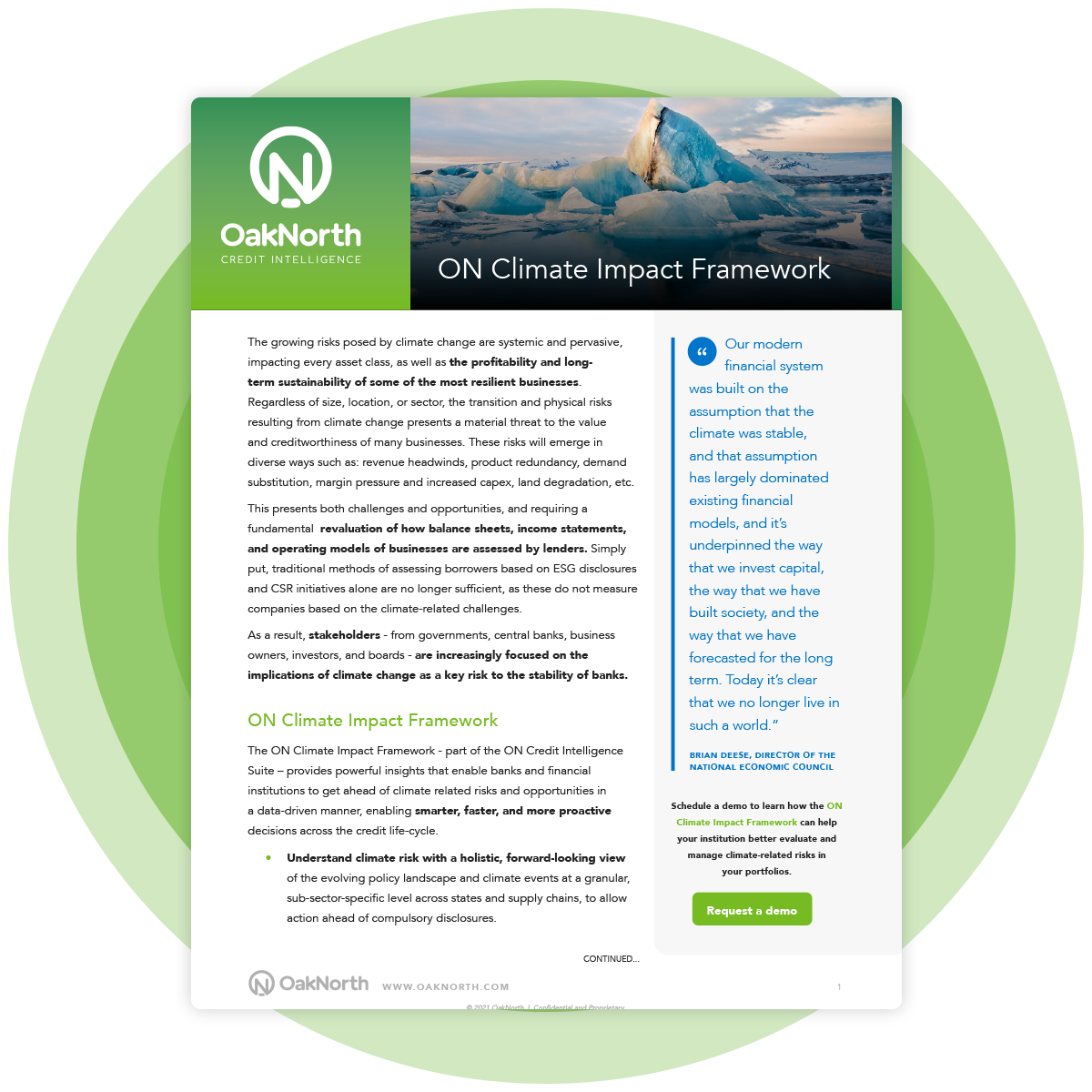OakNorth's Response to OCC’s ‘Five Questions Every Bank Board Should Ask’
The Acting Comptroller of the Currency, Michael J. Hsu, recently discussed climate change risk and highlighted the need to “move the climate conversation from the offices of scientists, policymakers, and regulators to bank boardrooms.” Specifically, he highlighted five climate change-related questions that bank boards of directors should be asking their senior management.
OakNorth’s Climate Change Impact Framework helps banks quantify, report and act on climate change-related risks and opportunities in their commercial loan portfolio. Despite uncertainties, there are actions that banks can take today to begin to address the five questions posed by the OCC.
1. What is our overall exposure to climate change?
Hsu’s main points:
- Banks will need to develop frameworks, data, and scenarios that analyze their potential exposure to physical and transition risks.
- Boards will want to know how material and manageable that exposure is – this will require both quantitative and qualitative data and analysis.
- Boards will need to balance a top-down and bottom-up approach to assessing climate risk (appreciating the complexities that this entails).
- In the meantime, banks should engage in “small s” scenario testing – asking granular “what if” questions that impact parts of banks’ portfolios.
What can you do now?
- Identify scenarios: While no climate scenarios have yet been released by US regulators, there are strong precedents from mainland Europe and the UK, as well as the FSOC report on climate-related financial risk which provide several recommendations with regards to scenario analysis. Banks should consider a broad range of scenarios with sufficient granularity.
- Identify data needs: banks need to determine what can be achieved with current borrower-level information (industry classification and financial statements) and what additional data is needed to ask those more granular “what if” questions. It is essential for banks to get their data in order and develop a plan to evolve their data management and measurement capabilities further.
- Identify a framework: a framework will help your bank apply those climate risk scenarios to understand specific impacts on your portfolio and individual borrowers.
2. Which counterparties, sectors, or locales warrant our heightened attention and focus?
Hsu’s main points:
- Climate change will significantly impact the creditworthiness of some borrowers and sectors.
- A combination of physical and transition risks can impact borrower solvency and the value of their underlying assets.
- Therefore, identifying those borrowers and sectors which are most likely to see deterioration in creditworthiness is a critical first step.
What can you do now?
- Consider how you could develop your framework and scenarios at a sector, subsector, borrower and geographic level.
- Understand differing impact by sector – as well as impact within a sector. For example, within manufacturing and the subsector of automobile manufacturing - a manufacturer of electric vehicles will likely fare better than a traditional car manufacturer as changing consumer demand (transition risk) impacts sales.
- Design your framework with borrower level analysis in mind (even if not immediate) – for example, how would a vegetarian-focused restaurant fare compared to a steakhouse if demand for beef decreases in the future?
3. How exposed are we to a carbon tax?
Hsu’s main points:
- Transition risks are difficult to forecast – but banks need to start their analysis somewhere.
- A boundary case such as the adoption of a carbon tax may serve as a good candidate for initial analysis.
- Akin to a “severely adverse” scenario in CCAR, it identifies the most significant exposures/ concentrations of risk/highly correlated positions – and in doing so, helps improve processes, data collection and frameworks for more complex transition risk analysis in the future.
What can you do now?
- Identify the sectors most impacted by carbon tax.
- Given uncertainties around the quantum and application of carbon tax, evaluate multiple scenarios and how they impact sectors.
- Using your framework, apply sector impacts to individual borrowers – initially based on sector-level assumptions and parameters.
- Ultimately, this will enable quantification of carbon tax impact by sector and individual borrowers in a bank’s loan portfolio, including parameters such as leverage, profitability, etc.
4. How vulnerable are our data centers and other critical services to extreme weather?
Hsu’s main points:
- Households, businesses and the financial system rely on banks to maintain continuous operations.
- Exposure of banks’ data centers to extreme weather events needs to be understood, as well as climate risks for banks’ third-party vendors.
What can you do now?
- Identify operational risk: banks need to develop a clear understanding of their existing operations, the entities performing such operations, the locations where these operations take place, any back-up sites, and any cross-sector dependencies.
- Invest in technology: banks need a flexible technology-based solution which is able to dynamically adapt to new data, and enable the analysis and modeling of operational risks, hazards, and vulnerabilities.
5. What can we do to position ourselves to seize opportunities from climate change?
Hsu’s main points:
- Climate change presents opportunities as well as risks.
- Banks with strong climate risk management systems not only will be better prepared to withstand climate change events, but also have a competitive advantage with regard to climate-related business opportunities.
What can you do now?
- Bring together leaders from across your business – not just risk and credit, but also those who are customer-facing.
- As you build a framework and scenarios for analysis, incorporate the transition to lower-emission operations through investment in clean technology not only at the sector, but also at the borrower level.
- In addition to specific “sustainable finance” or “green funds,” start to consider how climate risk and opportunity will impact broadly across your commercial business.
- Don’t wait for regulation to come: if an institution can demonstrate industry and community leadership on climate change risk before the regulatory requirements come in, it will be able to better serve its customers in their transition to greener operations. This in turn, will benefit both the bank’s bottom line and its reputation.

